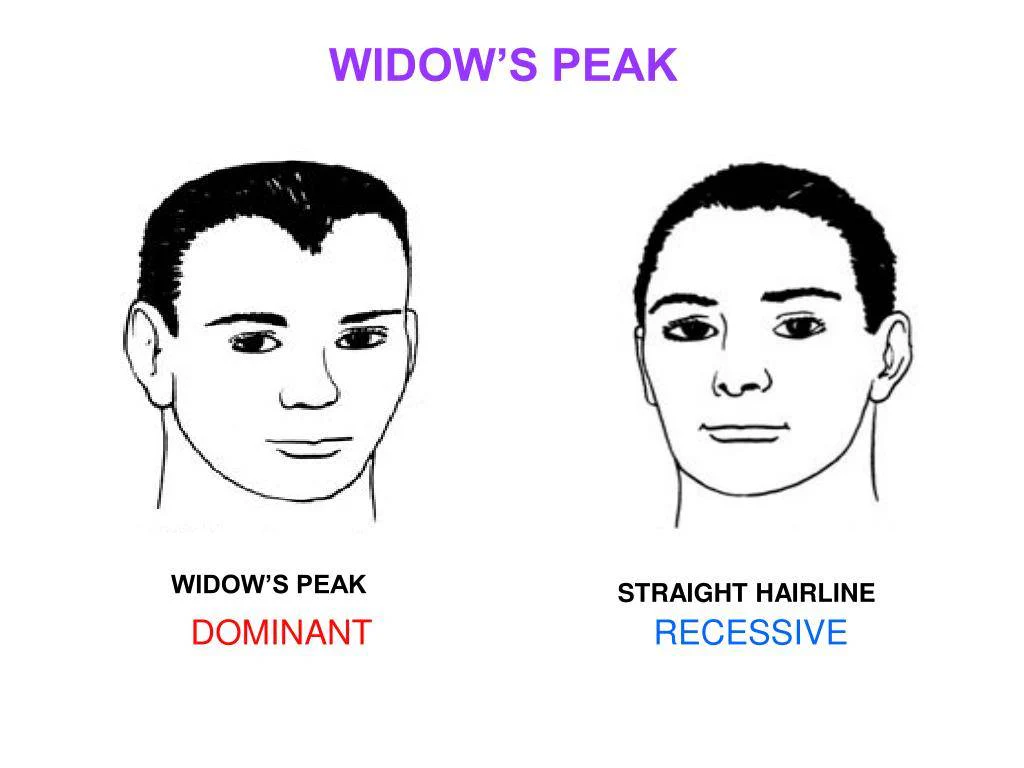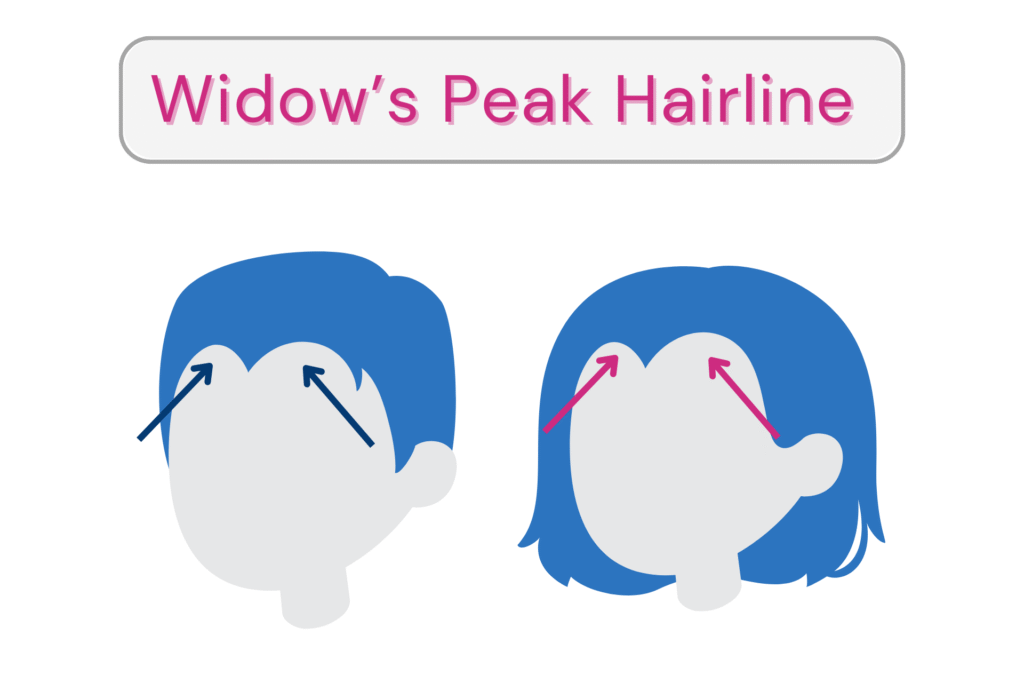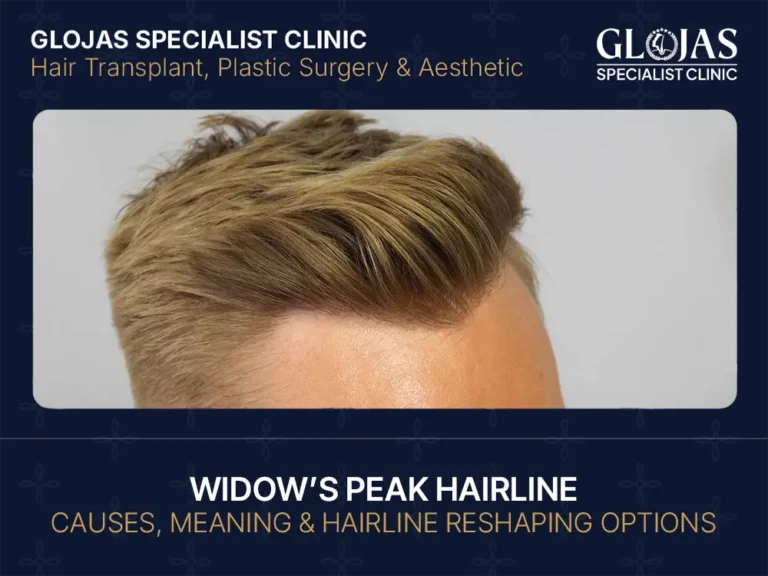What Is a Widow’s Peak?
A widow’s peak refers to a V-shaped hairline where the hair dips at the center of the forehead. This trait is typically genetic and may vary in depth and prominence. While some individuals embrace it as a unique feature, others may feel it creates an aged or unbalanced facial appearance—especially when combined with temple recession or hair loss.

Widow’s Peak vs. Receding Hairline
A common misconception is that a widow’s peak is a sign of balding. In truth, a widow’s peak is a natural hairline shape, while a receding hairline results from active hair loss. However, if hair loss occurs at the temples, it may exaggerate the V-shape, making it appear more dramatic or unflattering.
What Causes a Widow’s Peak?
The primary cause is genetics. A widow’s peak is an inherited dominant trait, meaning if one parent has it, there’s a high chance you will too. Hormonal conditions and hair disorders like frontal fibrosing alopecia can sometimes affect the shape or progression of the hairline.

Can a Widow’s Peak Be Corrected?
Yes—widow’s peak correction is possible with both surgical and non-surgical techniques:
1. Hair Transplant Surgery

For permanent reshaping, Follicular Unit Extraction (FUE) is the gold standard. This technique adds density to the temples or recontours the peak into a straighter line.
2. Laser Hair Removal
This method is ideal for those seeking a subtle reshaping. It’s often used by women who prefer a less pronounced peak and want a more feminine hairline.
3. Medical Hairline Design
Professionals can map out the ideal hairline design based on facial balance, symmetry, and hair density. This is essential for a natural-looking outcome, especially in Asian patients where conservative correction is preferred.
Who Should Consider Hairline Reshaping?
Individuals who feel their widow’s peak makes their face appear long or aged
Men with early signs of temple recession
Women seeking facial harmonization for aesthetic confidence
Patients undergoing gender-affirming hairline adjustment
Anyone looking to refine their frontal hairline permanently
Widow’s Peak Treatment Cost in Malaysia
Prices vary depending on the technique:
Hair Transplant (FUE): RM 6,000–RM 15,000
Laser Hair Removal: RM 300–RM 800 per session
Hairline Design Consultation: Often included in package
Choose a provider with LCP-certified doctors and MOH-approved devices.
Conclusion
A widow’s peak is not a flaw—it’s a natural hairline shape that some embrace and others choose to reshape. Whether your concern is genetic hairline, asymmetry, or age-related changes, advanced hair restoration in Malaysia offers safe, effective solutions to achieve your desired look with confidence.
FAQs About Widow’s Peak
1. Is widow’s peak hereditary?
Yes. It is a dominant trait passed down genetically, and is not caused by balding.
2. Can I fix my widow’s peak without surgery?
Yes, laser hair removal or semi-permanent reshaping can soften its appearance.
3. Is widow’s peak only seen in men?
No. It affects both genders, although women are more likely to seek cosmetic reshaping.
4. What’s the best treatment for widow’s peak in Malaysia?
Hair transplant (FUE) offers permanent reshaping, while laser removal suits mild adjustments.
5. How long is recovery after widow’s peak correction?
FUE recovery is about 7–10 days. Laser hair removal has no downtime.
Ready to Reshape Your Hairline?
At GLOJAS Specialist Clinic, our LCP-certified doctors offer personalized widow’s peak correction using proven techniques like FUE hair transplant and laser reshaping. Achieve natural results with medical precision and minimal downtime.
Book your consultation today — and redefine your confidence.
Expert Insights From GLOJAS Specialist Doctors
Some people are born with a distinctive hairline, whether it’s a soft curve, a sharp angle, or the classic widow’s peak hairline that forms a point. For many men and women, this is simply part of their natural look, much like eye color or face shape. A natural hairline can be seen as a sign of individuality, but in some rare cases, it might also be an early sign of a genetic condition. Disorders such as frontonasal dysplasia, donnai barrow syndrome, or opitz G BBB syndrome—sometimes linked to mutations in the LRP2 gene—can influence facial features and hairline development. These conditions, often described as syndrome a rare genetic disorders, show how much our genetics shape the way we appear.
For others, the focus isn’t on genetics but on confidence and style. People concerned about hair growth or thinning hair follicles might explore treatments like hair transplant procedures or even laser hair removal, depending on whether they want to restore or reduce hair. Pop culture has also highlighted this feature—icons like Keanu Reeves and Marilyn Monroe are remembered not only for their talent but also for their memorable hairline shape and presence. Whether inherited, medically influenced, or styled to preference, a prominent widow or smooth hairline can become part of someone’s identity, blending science, health, and beauty into the story of who they are.
